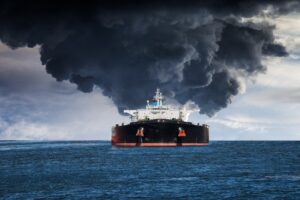The earth is getting warmer. According to the 2021 report of the Intergovernmental Panel on Climate Change (IPCC), the global climate will warm between 2.1 to 3.9 degrees Celsius by 2100. As a consequence, droughts, extreme weather phenomena and rising sea levels threaten our life on earth.
To prevent this, climate-damaging greenhouse gases must be reduced. International maritime shipping has a key role to play in this. The industry’s Getting to Zero coalition’s call to action aims at accelerating the decarbonisation of shipping. Bernhard Schulte Shipmanagement (BSM), for example, has reaffirmed its long-standing commitment to sustainability by signing the call to action.
Part of the solution is the development of alternative propulsion methods for further emissions reduction, as 99% of the world’s merchant fleet runs on conventional fuels. Since the beginning of 2020, the new MARPOL regulations have focused on reducing SOx and NOx emissions through low-sulphur marine fuels and diesel. But more is needed.
The order books show that more and more newbuildings with “green” propulsion systems are coming onto the market. One in nine new ships is powered by alternative fuels – mainly large ships. LNG as a fuel minimises SOx and NOx emissions, but fuels such as ammonia, hydrogen and methanol are alternatives for the next step in emissions reduction: reducing CO2 emissions, the predominant greenhouse gas.
Ammonia has major advantages when compared to other alternative fuels. The chemical compound consists of one nitrogen atom and three hydrogen atoms. Since it is not a carbon compound, it burns carbon-free. This is a huge advantage that could contribute to the creation of a more sustainable maritime industry. Further “green” energy sources such as wind, solar and water energy can be used to produce ammonia.
Compared to other fuel technologies ammonia solutions build on established technologies and infrastructure. Ammonia is produced and handled on a large scale as fertiliser. Therefore, it can be easily handled in port terminals, which helps to significantly shorten the path to sustainability.
The storage of ammonia is relatively easy, as ammonia only needs to be cooled to minus 33 degrees Celsius to become liquid. In comparison hydrogen needs to be cooled to minus 253 degrees. When Ammonia is compressed at 9 bar 20 degrees Celsius is sufficient for ammonia to become liquid. This makes transport and storage easier and cost-efficient.
Furthermore, ammonia can not only be burned in engines but can also be used as a hydrogen carrier to power fuel cells. For this purpose, the hydrogen is largely separated from the ammonia. Pure nitrogen escapes into the air or is fed to the fuel cell together with the hydrogen.
Wärtsilä and MAN, the largest engine manufacturers in the industry, are working on providing ammonia-powered engines for shipping. MAN aims to deliver the first CO2 emission-free two-stroke engine powered by ammonia in 2024.
And the third-party ship manager BSM is also investing in this future technology together with Amon Maritime. They have established ULA Shipmanagement, a 50/50 joint venture based in Sandefjord, Norway. Both companies will offer ship management solutions that focus on the Norwegian market and specialise in ammonia-powered ships but are open to all vessel types.
As the industry increasingly adapts to the challenges of climate change, there is no doubt that ammonia will be an important carbon-free energy source in tomorrow’s shipping world, helping the industry to make a considerable contribution to decarbonising the world.









